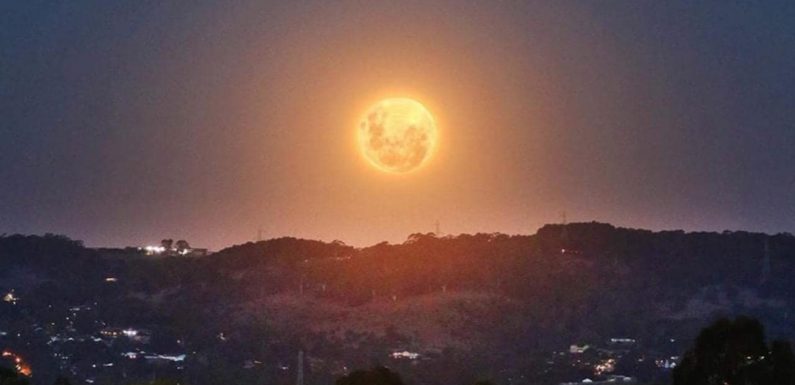
Stargazers keen to capture a rare “blood supermoon” tonight should allow plenty of time for preparation – and not bother with their phone camera, an expert says.
From Wednesday afternoon, a huge full moon will slowly rise into the sky before nightfall hits, when it will turn a light copper-red.
The change in colour happens when the Earth lines up between the Moon and the Sun and blocks out most of the blue light, sending the moon’s surface to look like it has a red glow.
What’s so special about the event is that it could be several years before we see one so clearly again.
RELATED: How to watch the Super Blood Moon
This is where to see the Supermoon. Picture: Brett NockoldsSource:Supplied
RELATED: Super Blood Moon will cause a lot of relationships to break-up
For about 13 minutes from 9.11pm on Wednesday until 9.25pm, the moon’s closest point of orbit with the Earth is due to coincide with total lunar eclipse – making for the first blood supermoon since 1982.
According to Astronomy.com, the rather exclusive eclipse will only be visible to people in Australasia, east Asia, across the Pacific Ocean and certain parts of North and South America.
Speaking to the New Zealand Herald, Stardome astronomy educator and astro-photographer Josh Kirkley provided a few tips to get the best shot of the spectacle.
RELATED: Qantas launch supermoon flight
The supermoon will be at its best viewing point between 9pm and 9.30pm. Picture: Matthew WelsbySource:Supplied
“Look for clear unobstructed night sky views. The blood supermoon will be visible high in our sky so you should be able to find a good spot,” Kirkley said.
“When the Moon goes into Earth’s shadow – the reddish light passing through Earth’s atmosphere will be refracted on to the Moon, creating a blood-red colour across the lunar surface.”
How to take the best photo of the moon
Mr Kirkley said anyone who wanted real photos of the moon should forget their iPhone and borrow a DSLR or mirrorless camera, with interchangeable lenses.
“Phone cameras just won’t cut it for a nice clear shot,” he said.
“Many standard cameras come with 18-50mm lenses, but I’d recommend lenses closer to the 300-600mm mark to get crisp close-up shots of the Moon.”
The higher the number, he said, the better.
“Ideally, you’ll also need a tripod, as night photography with handheld cameras will inevitably end up blurry.”
Taking a photo of the phone on your iPhone is not recommended. Picture: Campbell BrodieSource:News Limited Network
Next, moon-shooters needed to ensure their settings were sorted before the big moment.
“To focus on the Moon, first you must turn off AF which is auto-focus,” he said.
“This is a physical button on most lens bodies, and it must be changed to MF or manual focus so you can properly focus on the Moon.
“From here, you typically turn the ring around the end of a lens to focus on the object.”
Once the moon was in clear focus, the next step was to ensure the aperture of the camera lens was as wide as possible.
“This is known as f-stop, and it basically means how much light your lens will let into the sensor,” Kirkley said.
“The lowest possible aperture number for your lens will be best, as it allows you to take faster photos that capture more light.”
Qantas will launch the supermoon flight
The Qantas one-off “flight to nowhere” to view the supermoon and lunar eclipse occurring tonight will ultimately give passengers the best possible view of the event from a seat on their Boeing 787 Dreamliner.
The flight sale, in which all seats sold out in just two-and-a-half minutes of online sales, saw economy fares on the flight at $499, $899 for premium economy and $1499 for business class seat.
Qantas will launch the supermoon flight on Wednesday evening. Picture: Dylan Coker/NCA NewsWireSource:News Corp Australia
The lucky passengers will take off from Sydney Airport and climb to a cruising altitude of 43,000 feet, well above any clouds and away from the city’s light pollution.
Qantas pilots have worked with the CSIRO to develop the optimal flight path over the Pacific Ocean to catch the supermoon in all its glory.
The flight will be piloted by Qantas’ 787 fleet technical manager, Captain Alex Passerini.
“That moon is 240,000 miles [384,000km] away but we’ll be about 12km closer to it, at about 40,000 feet,” he said.
The flight sold out in two minutes. Picture: Dylan Coker/NCA NewsWireSource:News Corp Australia
“We’re working with the CSIRO to develop a flight plan that will give us the best viewing, making sure we get those times right for exactly when the lunar eclipse is going to be at its peak, so we can afford everyone on board the best possible view while that’s happening.
“We’ll be above the weather, getting that great view from the larger windows and not being subject to the light pollution in the Sydney area because that affects viewing.”
The moon will be at its closest point at 11.50am AEST on May 26, coming within 357,311km of Earth.
The total lunar eclipse will occur between 9.11pm and 9.25pm AEST, when the moon is 357,462km from Earth.
trending in travel
Source: Read Full Article















